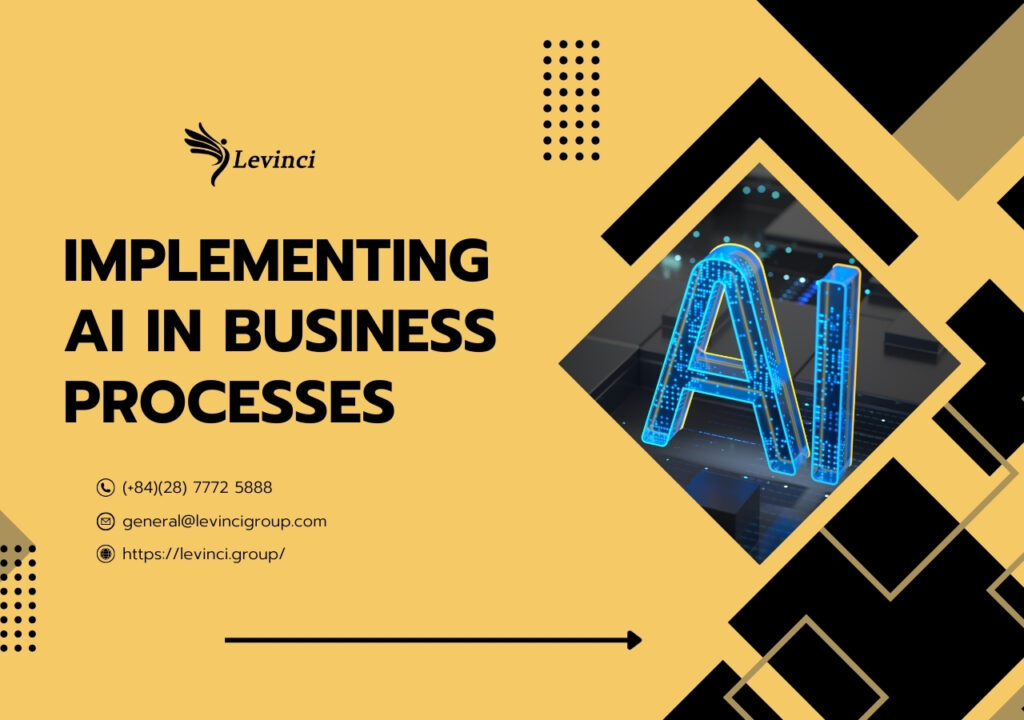In today’s rapidly evolving business landscape, implementing Artificial Intelligence (AI) is no longer a luxury but a necessity for organizations looking to stay competitive. From automating repetitive tasks to enhancing decision-making and improving customer experiences, AI is transforming how businesses operate across industries. However, integrating AI into business processes can seem daunting without a clear and practical approach. In this article, Levinci will explore how businesses can effectively implement AI, streamline operations, and unlock new opportunities for growth.
The role of AI in modern business operations
AI isn’t just a fancy tool, it’s the engine that powers these necessities. Here’s a detailed breakdown of why AI is so vital:
- Repetitive task automation: AI excels at automating mundane, repetitive tasks that consume valuable human capital. Think data entry, invoice processing, customer support inquiries (through chatbots), and even aspects of manufacturing. This frees up your human workforce to focus on higher-level strategic thinking, creativity, and complex problem-solving.
- Increased speed and productivity: AI-powered systems can perform tasks far faster and more accurately than humans. This translates directly into increased productivity, faster turnaround times, and ultimately, a more agile and responsive business.
- Reduced errors: AI, when properly trained, operates with consistent accuracy, minimizing mistakes in critical processes, from financial reporting to quality control.
- Big data analysis: We’re living in an era of massive data generation. AI algorithms can sift through vast datasets such as customer behavior, market trends, operational data at speeds and scales impossible for humans. This uncovers hidden patterns, correlations, and insights that can inform strategic decisions.
- Predictive analytics: AI can leverage historical data to forecast future trends, customer behavior, and potential risks. This allows businesses to proactively optimize inventory, anticipate demand fluctuations, personalize marketing efforts, and mitigate potential problems before they escalate.
- Personalized experiences: AI powers recommendation engines, personalized marketing campaigns, and tailored customer service interactions. By understanding individual customer preferences and behaviors, businesses can deliver more relevant and engaging experiences, leading to increased customer satisfaction and loyalty.

How to select the best AI tools for your business
Choosing the right AI tools and technologies is a critical decision for businesses looking to integrate artificial intelligence into their operations. With a wide array of AI tools and platforms available in the market, selecting the best ones to meet specific business needs can be a daunting task. The key to making an informed choice lies in understanding your company’s unique requirements, the features of various AI tools, and the long-term scalability and adaptability of the technologies you choose.
Clarifying business needs
Before diving into the wide world of AI tools, businesses must clearly define the problems they aim to solve or the opportunities they hope to capitalize on. Are you looking to automate repetitive tasks, enhance customer service, improve decision-making, or optimize processes like supply chain management? Your goals will significantly influence the type of AI tools you need.
For example, if customer service is a priority, AI tools like chatbots or virtual assistants might be ideal. Alternatively, for predictive analytics or demand forecasting, machine learning (ML) models and big data analytics platforms would be more appropriate. Ensuring that your AI tools are aligned with your business objectives helps in narrowing down the options and making the right selection.
Exploring the different types of AI tools and technologies
There are various AI technologies, each suited to different business needs. To make the right choice, it’s essential to understand the types of tools available and how they can be leveraged effectively within your organization.
- Machine Learning (ML) Tools: These tools allow systems to learn from data and improve over time without being explicitly programmed. ML can be used for applications like predictive analytics, personalized recommendations, and anomaly detection. Some popular tools include Google’s TensorFlow, Microsoft Azure Machine Learning, and IBM Watson.
- Natural Language Processing (NLP): NLP tools enable machines to understand and process human language. If your business involves processing large amounts of text data or building intelligent chatbots, NLP technologies like OpenAI’s GPT or Google Cloud NLP would be beneficial.
- Robotic Process Automation (RPA): RPA tools are designed to automate repetitive, rule-based tasks that traditionally require human intervention. RPA is widely used for tasks like data entry, invoice processing, and customer service interactions. Tools like UiPath and Automation Anywhere are popular in this category.
- AI-Powered Analytics: For businesses looking to derive insights from big data, AI analytics tools use advanced algorithms to find patterns, trends, and correlations in data. Tools like Tableau with AI integration or Power BI with advanced analytics capabilities can help businesses make data-driven decisions
Scalability and integration capabilities
When selecting AI tools, scalability is a crucial factor. As your business grows, your AI solutions need to scale seamlessly to accommodate increasing data volumes, more complex tasks, or higher demand for processing power. It’s essential to choose AI tools that are flexible and can scale with your business needs.
Your AI tools must integrate smoothly with your existing software systems, whether that’s an Enterprise Resource Planning (ERP) system, Customer Relationship Management (CRM) system, or data storage solution. Ensure that the tools you choose support common APIs and are compatible with your tech stack. A tool that doesn’t integrate easily into your existing infrastructure could lead to inefficiencies or even the failure of the AI initiative.

Cost considerations
AI technology can be expensive, particularly for small or medium-sized businesses. It’s important to balance the cost of an AI tool with the potential return on investment (ROI). While some advanced AI tools may require significant upfront investments, there are many cloud-based, subscription-based models available that allow businesses to pay for only what they use, making AI adoption more accessible.
It’s also important to consider hidden costs, such as the need for training staff, ongoing support, and maintaining the system. Make sure to calculate the total cost of ownership (TCO) before committing to a particular AI tool or platform.
User-friendliness and support
The usability of AI tools is another critical factor in the selection process. The tool you choose should be easy for your team to use, even if they don’t have a deep technical background. A tool with a steep learning curve might delay the benefits of AI adoption or result in poor implementation.
Look for tools that come with user-friendly interfaces, clear documentation, and a supportive community. Some vendors offer training programs, tutorials, and extensive customer support to ensure smooth implementation. Evaluate the level of customer service and support provided by the vendor, as ongoing assistance is crucial to resolving issues and optimizing the tool’s performance.
Security and compliance
AI tools can handle sensitive data, making security and compliance essential factors to consider. Ensure that the AI tools you select adhere to relevant data protection regulations, such as GDPR, HIPAA, or CCPA, depending on your industry and geographic location.
Moreover, the tools should have robust security features, such as encryption, access control, and audit trails, to protect against unauthorized access and data breaches. In industries like healthcare or finance, strict regulatory compliance and data privacy are non-negotiable, so choosing AI tools with built-in compliance features is essential.
Vendor reputation and reliability
Finally, consider the reputation and reliability of the AI tool vendors. Established vendors with a track record of successful AI implementations and customer satisfaction can provide more confidence in their products. Look for vendors with strong industry expertise, positive customer reviews, and a history of continuous innovation in AI technology.
Additionally, evaluate whether the vendor offers a clear roadmap for product updates and future developments. AI is a rapidly evolving field, so it’s important to choose vendors who are committed to ongoing research and improvement, ensuring their tools remain cutting-edge.

A step-by-step guide to implementing AI in business
Implementing AI in business processes can seem like a complex task, but when broken down into clear, actionable steps, it becomes much more manageable. These steps not only ensure that AI integration aligns with your business needs but also foster a smooth transition and maximize the benefits of AI technologies. Let’s explore the five critical steps in detail to successfully implement AI in business processes.
Step 1: Evaluating business processes before AI integration
The first step in implementing AI is to thoroughly assess your existing business processes. Before diving into AI solutions, it’s essential to understand your current workflows, challenges, and areas of inefficiency. This step involves identifying which processes can benefit most from AI, whether it’s automating repetitive tasks, improving data analysis, or optimizing decision-making.
Step 2: Setting clear objectives for AI success
Once you’ve assessed your current processes, it’s time to define clear, measurable objectives and goals for the AI implementation. This step ensures that the AI solution aligns with business needs and sets expectations for success.
Step 3: Selecting the best-fit AI solution
After setting clear goals, the next step is selecting the right AI solution that aligns with your business needs. There are numerous AI tools and platforms available, but choosing the right one requires an in-depth understanding of your requirements.
Step 4: Training employees and ensuring buy-in
Successful AI implementation goes beyond technology, it’s also about your people. For AI to work, your employees must understand how to use it effectively, and they need to be on board with the changes. This is why training and buy-in are crucial.
Step 5: Tracking and enhancing AI performance
Once AI has been implemented and employees are trained, it’s time to focus on performance measurement and optimization. AI systems often require continuous monitoring to ensure that they’re working as intended and delivering the expected results.

Conclusion
Implementing AI in business processes offers immense potential to drive efficiency, enhance customer satisfaction, and foster innovation. While the journey to AI adoption may present challenges, with the right strategy, tools, and mindset, businesses can seamlessly integrate AI into their operations for long-term success. If you’re ready to take the next step in transforming your business, now is the time to explore how AI can revolutionize your processes and propel your business forward with Levinci.

